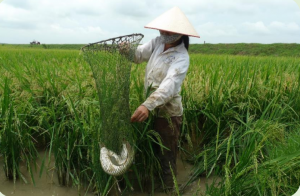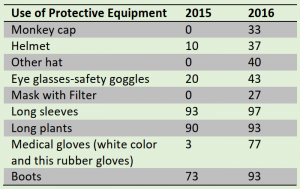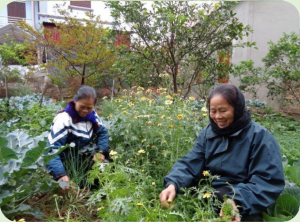Agroecology program in Xuan An and Ngoc Son, Vietnam
Introduction
 Located about 70 km north east from Hanoi, Vietnam, the villages of Xuan An and Ngoc Son (Bac Giang province) include 285 households. Rice is the main staple crop and its production extends for 98 ha, about 0.7 ha per household. Vegetables, mainly brassica species, tomatoes, herbs and potatoes are also produced on about 14 ha while fruit trees are grown in the house gardens. Local rice and vegetable production strongly relies on synthetic inputs specifically Nitrogen fertilizers and pesticides which increase production costs and raise concerns on the impact of farming on the environment and human health. Small scale livestock production systems are also part of the local agriculture and involve more than half of the families which raise pigs, chickens and ducks in the backyard.
Located about 70 km north east from Hanoi, Vietnam, the villages of Xuan An and Ngoc Son (Bac Giang province) include 285 households. Rice is the main staple crop and its production extends for 98 ha, about 0.7 ha per household. Vegetables, mainly brassica species, tomatoes, herbs and potatoes are also produced on about 14 ha while fruit trees are grown in the house gardens. Local rice and vegetable production strongly relies on synthetic inputs specifically Nitrogen fertilizers and pesticides which increase production costs and raise concerns on the impact of farming on the environment and human health. Small scale livestock production systems are also part of the local agriculture and involve more than half of the families which raise pigs, chickens and ducks in the backyard.
Challenges
Despite a varied production system, the limited land available per household and the high input costs, the local agricultural production is not enough to guarantee decent livelihoods for the local communities. As a result men and youth are forced to look for off-farm jobs outside the villages leaving the agricultural work load on the shoulders of 40-60 years old women. Over the last 10 years the vegetable area decreased by over 80% due to the high production costs (fertilizers, pesticides, labor), pests and diseases, thereby forcing farmers to buy vegetables in the market. In 20% of farmers different health problems were reported such as high blood pressure, gynaecological diseases and premature birth has increased probably as a result of the large application of agrochemicals and the limited use of personal protective equipment (PPE). Children are also at risk as schools are surrounded by crop fields where insecticides and pesticides are sprayed and carried by the wind to the residential areas. PPE are rarely adopted by farmers while storage and particularly disposal of pesticides was not carried out safely. Pollutions from livestock by-products and manure mismanagement also affects the local environment and human health due to the gas emissions and odours rising from the backyard.
In such situation it was evident that the local production systems had to be re-designed in order to make agriculture more profitable and sustainable. Farmer’s participatory training and the direct involvement of farmers in the community planning process was identified to be crucial in this process which was supported by the Initiatives on Community Empowerment & Rural Development (ICERD), and The Field Alliance (TFA), FAO Asia Regional IPM/Pesticide Risk Reduction Programme, Department of Plant Protection (PPD)- Ministry of Agriculture and Rural Development (MARD) and the Ministry of Education and Training (MoET). The ICERD, TFA and FAO-IPM support for Xuan An and Ngoc Son are within the Sida funded regional program “Towards a non-toxic environment in South-East Asia”.
Description of the Agroecology system
A holistic agroecological program has been implemented since 2014 involving farmers, students and local institutions aiming at improving the livelihoods of the rural communities. The program includes:
Survey status of agrobiodiversity, impacts of pesticides on public health and environment conducted jointly by students and farmers;
Elaboration of data collected on pesticide risk reduction (PRR) in the communities and data dissemination to raise awareness and solicit support at the local, national, and regional levels;
Training of Trainers (ToT) on integrated production and pest management (IPPM) on rice, vegetables and livestock;
15 Farmer Field Schools (FFS), where a total of 378 farmers and students of which 299 woman were trained on IPM, PRR, agro-biodiversity conservation and use, System Rice Intensification (SRI), biological control, composting, bio-bedding, integrated rice-fish cultivation, vegetable production and crop-livestock integration to strengthen nutrient cycling within farms.
As a result of these trainings and there have been a variety of follow up activities organised by social organizations, farmers, students, and commune Peoples’ Committee with their own resources to sustain the program, such as:
Activities on pesticide risk reduction and ecological agriculture have been absorbed into the mainstream of the Commune People’s Committee strategic Plan on agricultural production and rural development.
Conservation and use of fish and aquatic animals in rice field/integration rice-fish-duck: Fish and ducks play a role in weed and pest control and thereby reduce herbicide and pesticide use and labour cost.
 Home garden/”integration of vegetableslivestock production” through biomats and composting: Many farms are raising pigs and chickens to serve the nutritional needs of the family and to generate income. However, livestock is usually kept nearby the house and cause pollution. Biomats are formed by a mixture of fermented biological agents with biomass and mulch from the floor of the livestock’s stables. This accelerates manure decomposition, and deodorize foul-smelling and poisonous gas from the shed. The residues of bio-mats is ultimately used to make compost as alternative to chemical fertilizer in “home gardens”.
Home garden/”integration of vegetableslivestock production” through biomats and composting: Many farms are raising pigs and chickens to serve the nutritional needs of the family and to generate income. However, livestock is usually kept nearby the house and cause pollution. Biomats are formed by a mixture of fermented biological agents with biomass and mulch from the floor of the livestock’s stables. This accelerates manure decomposition, and deodorize foul-smelling and poisonous gas from the shed. The residues of bio-mats is ultimately used to make compost as alternative to chemical fertilizer in “home gardens”.
“System of Rice Intensification, response to climate change”: SRI is applied to improve rice production as well as to create a suitable ecosystem for fish such as wide spacing. Furrows are created to improve drainage and also allow fishes enter to the field. Also alternatives to chemicals (bio-pesticides, compost and bio-fertilizer) are applied.
“Green environment day” organized by students to sensitize local communities on environmental issues and the need for sustainable farming practices
Construction of tanks for pesticide containers for disposal
Creation of a Woman’s Club: Participating women in FFSs organised themselves into a woman’s club. Initially it was about exchanging and sharing experiences on the conservation of aquatic animals and fish in rice fields as well as theatre and singing. Later on the activities were expanded to IPM, SRI, vegetable growing techniques, alternatives to chemical inputs, health and nutritional issues, input supply companies and dissemination of environmental friendly farming techniques.
Support to advocacy and information and dissemination of knowledge
Support to market access
Outcomes of the practices
Rice agroecology systems
Building on the FFS the local communities designed more efficient, productive and sustainable rice systems. Over 70% of rice area is now cultivated under IPPM and System of Rice Intensification (SRI) while rice-duck-fish cultivation has been adopted by 60 households in Xuan An and Ngoc Son. Nutrient cycling was enhanced through the recycling of residues and organic wastes in compost to be applied to rice fields thereby reducing fertilizer use by 76%. Rice seeds use was also reduced by 53% by improved sowing and transplanting techniques. Application of the Bio-agent Metharizume anisopliae (entomo-pathogen) was used to control brown plant hopper and replace pesticides. This minimised outbreak of brown plant hopper caused by overuse of chemical pesticides. Compared to 2014, pesticides were reduced in rice fields by about 78.6% in Xuan An and 74.6% in Ngoc Son and even by 100% in rice-duck-fish plots. When pesticides are used farmers are increasingly wearing Personal Protection equipment (PPE) (Table 1) and local authorities have mobilized funds to build 15 cement tanks for disposal of pesticide containers. SRI Fields have also shown increasing numbers of natural enemies (35%) and aquatic animal species (11.5%).

Straw burning is not practiced anymore in order to reduce environmental pollution and to recycle organic matter in soils. In no-tilled Rice-fish-duck fields compost and rice straw are crucial to improve the trophic relationships between insects, ducks and fish. Organic material stimulates insect communities which are basic elements of fish and ducks diet along with weeds. Ducks droppings represent an additional nutrient source for rice and also stimulates the phytoplankton growth which complements the fish diet. More than 30 women involved in rice-fish farming formed a women club to share experiences, problems and discuss possible solutions on riceduck-fish farming as well as other issues. Rice-fish farming did not only improve the sustainability of the local rice production but also diversified and significantly increased the gross margin from rice production.

Vegetables and livestock production after training program
 The trainings carried out during the program stimulated farmers’ interest in growing vegetables in the home gardens as a strategy to diversify diet and income. In Xuan An the Women’s Club had a crucial role in this process by attending and then organizing additional trainings on sustainable vegetable production. Farmers implemented highly diversified vegetable gardens by selecting local varieties and exchanging seeds among them. Chemical fertilizers and pesticides are not used in the vegetable gardens. Such a production system has attracted buyers from restaurants in Hanoi who are interested in local organic vegetables. So far in the Xuan An women’s club, there are 7 farmers who are in contact with restaurants and 21 others sell their vegetables at community markets. In Ngoc Son 25 farmers sell in the community or other markets. Only few farmers are supplying vegetables to restaurants but the number is rapidly increasing.
The trainings carried out during the program stimulated farmers’ interest in growing vegetables in the home gardens as a strategy to diversify diet and income. In Xuan An the Women’s Club had a crucial role in this process by attending and then organizing additional trainings on sustainable vegetable production. Farmers implemented highly diversified vegetable gardens by selecting local varieties and exchanging seeds among them. Chemical fertilizers and pesticides are not used in the vegetable gardens. Such a production system has attracted buyers from restaurants in Hanoi who are interested in local organic vegetables. So far in the Xuan An women’s club, there are 7 farmers who are in contact with restaurants and 21 others sell their vegetables at community markets. In Ngoc Son 25 farmers sell in the community or other markets. Only few farmers are supplying vegetables to restaurants but the number is rapidly increasing.
Small livestock production systems are located in the home gardens. The “Bio-mats” technology was tested by the Women’s Club and is increasingly adopted by the local community. To date 44 households in Xuan An and 27 in Ngoc Son apply Bio-mats.
The involvement of the younger generation was also a pillar of the program. Secondary school students were constantly involved in the trainings thereby playing a key role:
Presenting to the Commune authorities, Women’s Club, Farmer’s Union the results of their survey on current problem related to agrobiodiversity and risks associated with pesticide use;
Producing communication materials on the impact of unsustainable agricultural management on environment and human health;
Sharing with family members and the community in general the need to convert from external input-based agriculture to a more sustainable system involving vegetable and integrated farming system.
The activities of the students did not only raise awareness among farmers in transition towards agroecological systems but also played a crucial role at policy level. Students together with farmers managed to sensitize local institutions and mass associations towards the production and approval of community action plans such as the “Community Education Program on Pesticide Risk Reduction”.
Message from farmer to farmers
“We all can play a role in conserving and protecting our natural resources to achieve better livelihoods and produce more and more nutritious food. We believe that the three key factors for success are ‘cooperation, sharing and learning’”
— Message from Ms. Le Thi Hong, on behalf of members of Xuan An Woman Union of Xuan An.


